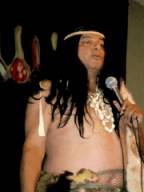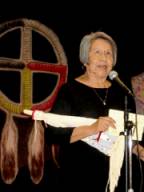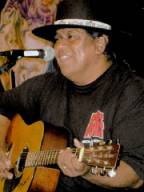Indian feed, Reality – Indian myth, America
By Roy Cook
November 14, 2009 Harvest dinner at the Barrio Station Auditorium 2175 Newton Ave, 92113, with reservations, can accommodate a larger number of happy faces to our community events. Particularly in these economically stressed times it is good to be able to open the door to the total community to enjoy the day. Here we are able to provide an opportunity for them to enjoy the time together with family and friends. Tracy Nelson and his blues are always entertaining. Abel Silvas ‘Running Grunion’ is the San Diego’s area best enactor educating the public to California Indian culture. It is always an inspiring experience to listen to Ms Shirley Apple Murphy experience and wisdom.



Each year, in the past, many groups and organizations have stepped up to make it happen. It still requires a driving force to see it through to the success that each year has produced. This year we need to recognize the Southern California American Indian Resource, SCAIR, San Diego Council of American Indian Organizations and Juan Castellanos of the Indian Human Resource Center, IHRC. Also, we need to recognize the Razo Family for organizing the food line and all the volunteers who help keep the food hot. We thank those members of the Urban Indian Community that donated Hams and cooked turkeys for this dinner. Soaring Eagles families also cooked turkeys and dropped them off before going to the Bonita Library for a performance the same day. We also appreciate Paula Brim and Chris from the Indian clinic along with Juan and his staff for their constant attention to detail and responsible diplomacy. Reality is good and tasty!

Indian Myth #1: “The First Thanksgiving” occurred in 1621.
Fact: No one knows when the “first” thanksgiving occurred. People have been giving thanks for as long as people have existed. Indigenous nations all over the world have celebrations of the harvest that come from very old traditions; for Native Tribal peoples, thanksgiving comes not once a year, but every day, for all the gifts of life. To refer to the harvest feast of 1621 as “The First Thanksgiving” shifts the focus from the event to the European and diminishes Indian peoples to a caricature in the eyes of non-Native children.
Myth #2: The people who came across the ocean on the Mayflower were called Pilgrims.
Fact: The Plymouth settlers did not refer to themselves as “Pilgrims.” Pilgrims are people who travel for religious reasons, such as Muslims who make a pilgrimage to Mecca. Most of those who arrived here from England were religious dissidents who had broken away from the Church of England. They called themselves “Saints”; others called them “Separatists.” Some of the settlers were “Puritans,” dissidents but not separatists who wanted to “purify” the Church. It wasn’t until around the time of the American Revolution that the name “Pilgrims” came to be associated with the Plymouth settlers, and the “Pilgrims” became the symbol of American morality and Christian faith, fortitude, and family.
Myth #3: The colonists came seeking freedom of religion in a new land.
Fact: The European colonists were not innocent refugees from religious persecution. By 1620, hundreds of Native people had already been to England and back, most as captives; so the Plymouth colonists knew full well that the land they were settling on was inhabited. Nevertheless, their belief system taught them that any land that was “unimproved” was “wild” and theirs for the taking; that the people who lived there were roving heathens with no right to the land. Both the Separatists and Puritans were rigid fundamentalists who came here fully intending to take the land away from its Native inhabitants and establish a new nation, their “Holy Kingdom.” The Plymouth colonists were never concerned with “freedom of religion” for anyone but themselves.
Myth #4: When the “Pilgrims” landed, they first stepped foot on “Plymouth Rock.”
Fact: When the colonists landed, they sought out a sandy inlet in which to beach the little boat that carried them from the Mayflower to the mainland. This boat would have been smashed to smithereens had they docked at a rock, especially a Rock. Although the Plymouth settlers built their homes just up the hill from the Rock, William Bradford in Mourt’s Relation: A Journal of the Pilgrims at Plymouth, does not even mention the Rock; writing only that they “unshipped our shallop and drew her on land.” The actual “rock” is a slab of Dedham granodiorite placed there by a receding glacier some 20,000 years ago. It was first referred to in a town surveying record in 1715, almost 100 years after the landing. Since then, the Rock has been moved, cracked in two, pasted together, carved up, chipped apart by tourists, cracked again, and now rests as a memorial to something that never happened.
It’s quite possible that the myth about the “Pilgrims” landing on a “Rock” originated as a reference to the New Testament of the Christian bible, in which Jesus says to Peter, “And I say also unto thee, Thou art Peter, and upon this rock I will build my Church and the Gates of Hell shall not prevail against it.” (Matthew 16:18) The appeal to these scriptures gives credence to the sanctity of colonization and the divine destiny of the dominant culture. Although the colonists were not dominant then, they behaved as though they were.
Myth #5: The Pilgrims found corn.
Fact: Just a few days after landing, a party of about 16 settlers led by Captain Myles Standish followed a Nauset trail and came upon an iron kettle and a cache of Indian corn buried in the sand. They made off with the corn and returned a few days later with reinforcements. This larger group “found” a larger store of corn, about ten bushels, and took it. They also “found” several graves, and, according to Mourt’s Relation, “brought sundry of the prettiest things away” from a child’s grave and then covered up the corpse. They also “found” two Indian dwellings and “some of the best things we took away with us.” There is no record that restitution was ever made for the stolen corn, and the Wampanoag did not soon forget the colonists’ ransacking of Indian graves.
Myth #6: Samoset appeared out of nowhere, and along with Squanto became friends with the Pilgrims. Squanto helped the Pilgrims survive and joined them at “The First Thanksgiving.”
Fact: Samoset, an eastern Abenaki chief, was the first to contact the Plymouth colonists. He was investigating the settlement to gather information and report to Massasoit, the head sachem in the Wampanoag territory. In his hand, Samoset carried two arrows: one blunt and one pointed. The question to the settlers was: are you friend or foe? Samoset brought Tisquantum (Squanto), one of the few survivors of the original Wampanoag village of Pawtuxet, to meet the English and keep an eye on them. Tisquantum had been taken captive by English captains several years earlier, and both he and Samoset spoke English. Tisquantum agreed to live among the colonists and serve as a translator. Massasoit also sent Hobbamock and his family to live near the colony to keep an eye on the settlement and also to watch Tisquantum, whom Massasoit did not trust. The Wampanoag oral tradition says that Massasoit ordered Tisquantum killed after he tried to stir up the English against the Wampanoag. Massasoit himself lost face after his years of dealing with the English only led to warfare and land grabs. Tisquantum is viewed by Wampanoag people as a traitor, for his scheming against other Native people for his own gain. Massasoit is viewed as a wise and generous leader whose affection for the English may have led him to be too tolerant of their ways.
Myth #7: The Pilgrims invited the Indians to celebrate the First Thanksgiving.
Fact: According to oral accounts from the Wampanoag people, when the Native people nearby first heard the gunshots of the hunting colonists, they thought that the colonists were preparing for war and that Massasoit needed to be informed. When Massasoit showed up with 90 men and no women or children, it can be assumed that he was being cautious. When he saw there was a party going on, his men then went out and brought back five deer and lots of turkeys.
In addition, both the Wampanoag and the English settlers were long familiar with harvest celebrations. Long before the Europeans set foot on these shores, Native peoples gave thanks every day for all the gifts of life, and held thanksgiving celebrations and giveaways at certain times of the year. The Europeans also had days of thanksgiving, marked by religious services. So the coming together of two peoples to share food and company was not entirely a foreign thing for either. But the visit that by all accounts lasted three days was most likely one of a series of political meetings to discuss and secure a military alliance. Neither side totally trusted the other: The Europeans considered the Wampanoag soulless heathens and instruments of the devil, and the Wampanoag had seen the Europeans steal their seed corn and rob their graves. In any event, neither the Wampanoag nor the Europeans referred to this feast/meeting as “Thanksgiving.”
Myth #8: The Pilgrims provided the food for their Indian friends.
 Fact:
It is known that when Massasoit showed up with 90 men and saw there was
a party going on, they then went out and brought back five deer and lots
of turkeys. Though the details of this event have become clouded in secular
mythology, judging by the inability of the settlers to provide for themselves
at this time and Edward Winslow’s letter of 1622 , it is most likely
that Massasoit and his people provided most of the food for this “historic”
meal.
Fact:
It is known that when Massasoit showed up with 90 men and saw there was
a party going on, they then went out and brought back five deer and lots
of turkeys. Though the details of this event have become clouded in secular
mythology, judging by the inability of the settlers to provide for themselves
at this time and Edward Winslow’s letter of 1622 , it is most likely
that Massasoit and his people provided most of the food for this “historic”
meal.
Myth #9: The Pilgrims and Indians feasted on turkey, potatoes, berries, cranberry sauce, pumpkin pie, and popcorn.
 Fact:
Both written and oral evidence show that what was actually consumed at
the harvest festival in 1621 included venison (since Massasoit and his
people brought five deer), wild fowl, and quite possibly nasaump—dried
corn pounded and boiled into a thick porridge, and pompion—cooked,
mashed pumpkin. Among the other food that would have been available, fresh
fruits such as plums, grapes, berries and melons would have been out of
season. Since it would have been too cold to dig for clams or fish for
eels or small fish. These to were not available. There was not enough
of the barley crop to make a batch of beer, nor was there a wheat crop.
Potatoes and sweet potatoes didn’t get from the south up to New England
until the 18th century, nor did sweet corn. Cranberries would have been
too tart to eat without sugar to sweeten them, and that’s probably
why they wouldn’t have had pumpkin pie, either. Since the corn of
the time could not be successfully popped, there was no popcorn.
Fact:
Both written and oral evidence show that what was actually consumed at
the harvest festival in 1621 included venison (since Massasoit and his
people brought five deer), wild fowl, and quite possibly nasaump—dried
corn pounded and boiled into a thick porridge, and pompion—cooked,
mashed pumpkin. Among the other food that would have been available, fresh
fruits such as plums, grapes, berries and melons would have been out of
season. Since it would have been too cold to dig for clams or fish for
eels or small fish. These to were not available. There was not enough
of the barley crop to make a batch of beer, nor was there a wheat crop.
Potatoes and sweet potatoes didn’t get from the south up to New England
until the 18th century, nor did sweet corn. Cranberries would have been
too tart to eat without sugar to sweeten them, and that’s probably
why they wouldn’t have had pumpkin pie, either. Since the corn of
the time could not be successfully popped, there was no popcorn.
Myth #10: The Pilgrims and Indians became great friends.
Fact: A mere generation later, the balance of power had shifted so enormously and the theft of land by the European settlers had become so egregious that the Wampanoag were forced into battle. In 1637, English soldiers massacred some 700 Pequot men, women and children at Mystic Fort, burning many of them alive in their homes and shooting those who fled. The colony of Connecticut and Massachusetts Bay Colony observed a day of thanksgiving commemorating the massacre. By 1675, there were some 50,000 colonists in the place they had named “New England.” That year, Metacom, a son of Massasoit, one of the first whose generosity had saved the lives of the starving settlers, led a rebellion against them. By the end of the conflict known as “King Philip’s War,” most of the Indian peoples of the Northeast region had been either completely wiped out, sold into slavery, or had fled for safety into Canada. Shortly after Metacom’s death, Plymouth Colony declared a day of thanksgiving for the English victory over the Indians.
Myth #11: Thanksgiving is a happy time.
Fact: For many Indian people, “Thanksgiving” is a time of mourning, of remembering how a gift of generosity was rewarded by theft of land and seed corn, extermination of many from disease and gun, and near total destruction of many more from forced assimilation. As currently celebrated in this country, “Thanksgiving” is a bitter reminder of 500 years of betrayal returned for friendship.

We hope to see you at the next Traditional; Winter Gathering Saturday
December 12, 2009 from 1:30pm on. It will be at the same ‘new’
place Barrio Station. The Holiday gathering committee can always use more
financial help, wrapped gifts, prizes for games and warm bodies to help
setting up, serving and cleaning up. Volunteer, call John at IHRC 619281-5964
and you will feel good about it. Thank you, Aho, Mehan.
Source: http://www.oyate.org/resources/shortthanks.html
http://www.americanindiansource.com/mourningday.html
